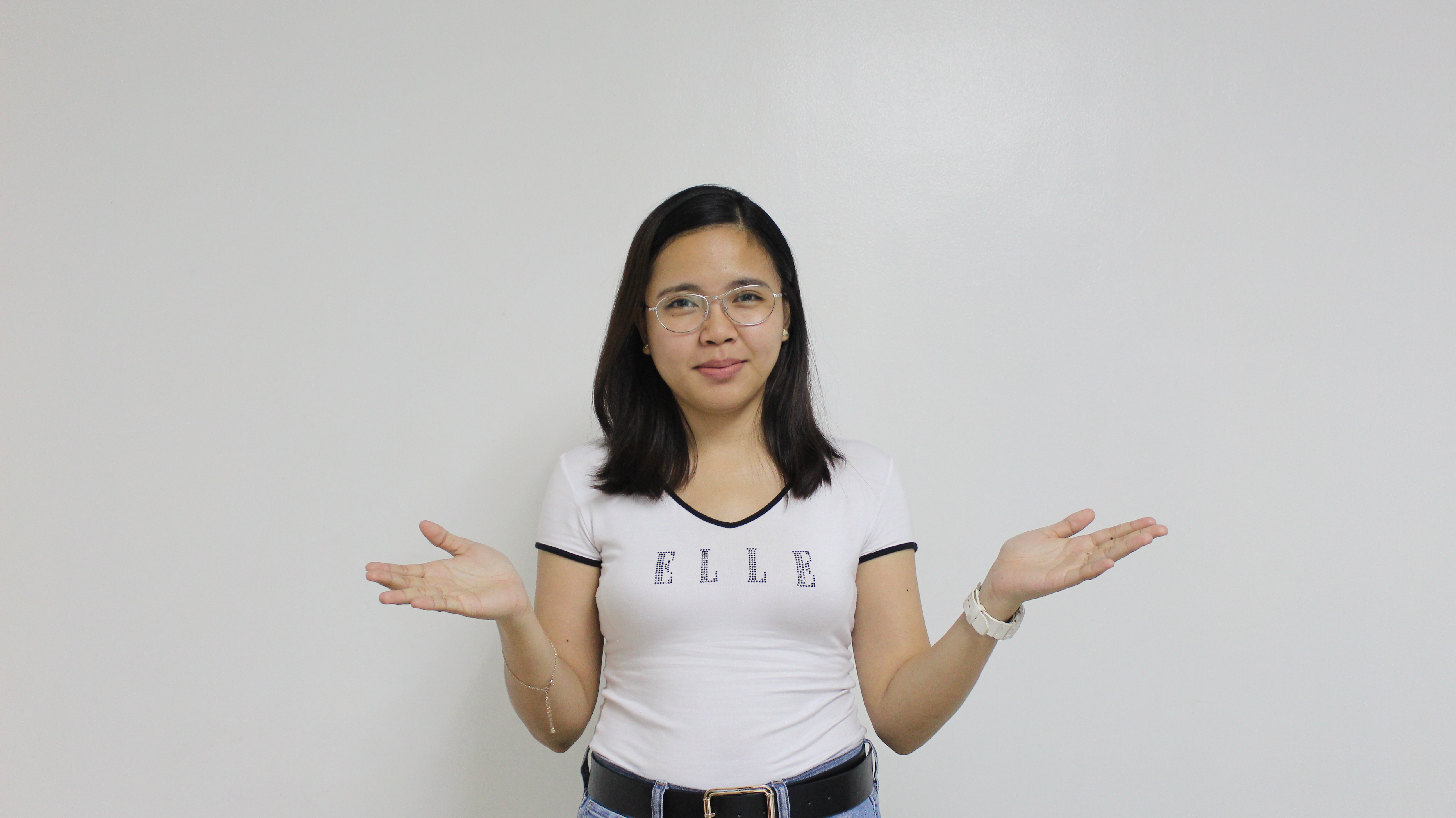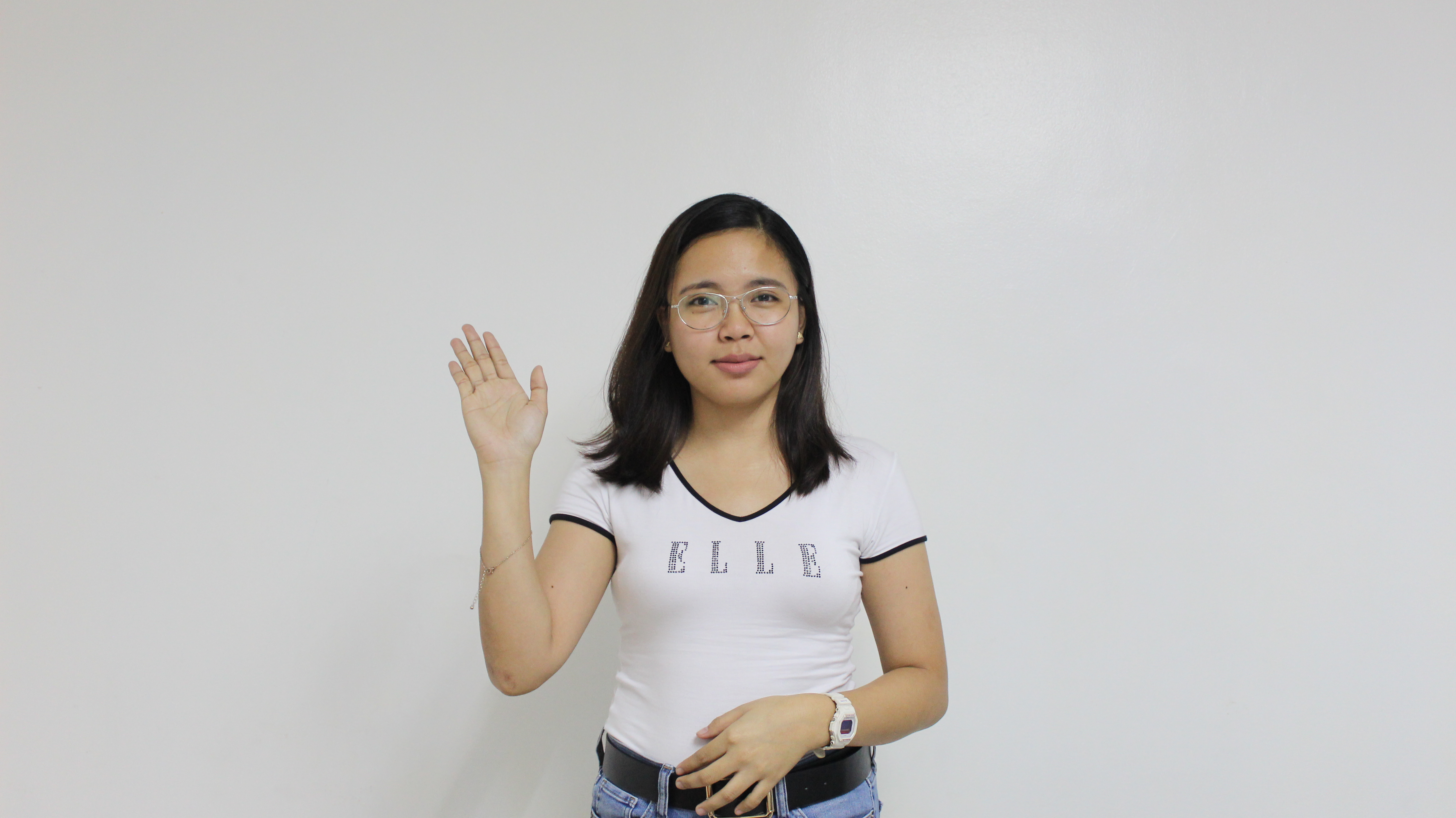Let’s read the vocabulary and sample sentences below. Please repeat after me.
単語と例文を音読します。講師の後に続いて読みましょう。
| EXPRESSION 表現 | |
|---|---|
| enroll 入学する |
Only 30 percent of students were enrolled in private universities. わずか30%の生徒が私立大学に入学しました。 |
| tuition fee 学費 |
The tuition fee in private universities is expensive. 私立大学の学費は高いです。 |
| offer 提供する |
The slots offered in private universities are limited. 私立大学の定員は限られています。 |
admit 入れる |
The rest of the students were admitted in state universities last school year. 昨年度、残りの生徒は州立大学に入りました。 |
| scholarship 奨学金 |
Schools should inform students of the scholarship programs offered in several private universities. いくつかの私立大学では奨学金制度があることを生徒に知らせるべきです。 |
Let’s practice the hand gestures below.
プレゼンテーション中に使うジェスチャーの練習をしましょう。

1. To greet or acknowledge(あいさつ)
For example:
Good morning. / Thank you for listening.

2. To introduce oneself(紹介)
For example:
Please let me introduce myself.

3. To show data(データの提示)
For example:
The graph shows…

4. To show numbers(数字の提示)
For example:
First… / Second…

5. To demonstrate(実演)
For example:
Please raise your hand.
Now, let’s watch the video. Your tutor will send a link to your chatbox.
ビデオを見ましょう。講師がチャットボックスにリンクを送ります。
Now, please read the presentation below. Emphasize the underlined words by doing the hand gestures shown in the video.
プレゼンテーションを読んでください。下線部ではビデオで見たジェスチャーを使ってみましょう。
Good morning, everyone.
みなさん、おはようございます。
It’s a great pleasure to be here today.
本日、ここに出席させていただき非常に光栄です。
Please let me introduce myself. I am Dan Wilson from North Shore High School.
自己紹介させてください。 North Shore高校より参りました Daisy Wilsonです。
In my presentation today, I’m going to report on the number of students enrolled in private universities last school year.
このプレゼンテーションでは昨年度、私立大学に入学した生徒数について報告します。
I will start the presentation now.
プレゼンテーションを始めます。
The graph shows that only 30 percent of students were enrolled in private universities. As you can see in the graph, the remaining 70 percent of students were enrolled in public universities. Based on a survey, the top 2 reasons why only 30 percent of students chose to enroll in private universities are the following. First, the tuition fee in private universities is expensive. Second, the slots offered in private universities are limited.
このグラフはたった30%の生徒が私立大学に入学したことを表しています。このグラフで分かるように、残りの70%の生徒は公立大学に入学しています。
アンケートによると、30%の生徒しか私立大学に入学しなかったか上位2つの理由は以下の通りです。
1つめは、私立大学の学費が高いことです。2つめは私立大学の募集枠が限られていることです。
In summary, only 30 percent of students were enrolled in private universities, while the rest were admitted in public universities last school year.
まとめると、昨年度私立大学に入学した生徒は30%、残りの生徒は公立大学に入学しました。
Please raise your hand if you have any questions.
質問がある方は手を上げてください。
Therefore, I conclude that schools should inform students of the scholarship programs offered in different private universities.
したがって、 いくつかの私立大学では奨学金制度があることを生徒に知らせるべきです。
Thank you for listening. Let’s now wrap it up for today.
ご静聴ありがとうございました。今日は終わりにしましょう。
Let’s read the vocabulary and sample sentences below. Please repeat after me.
単語と例文を音読します。講師の後に続いて読みましょう。
| EXPRESSION 表現 | |
|---|---|
| e-book 電子書籍 |
They use e-books in class because students find it more convenient. 便利なので、授業中に生徒は電子書籍を使います。 |
| function 機能 |
E-books have useful functions that physical books do not have. 電子書籍は、実際の本にはない便利な機能があります。 |
| frequently 頻繁に |
Students use e-books in English classes most frequently. 生徒は英語の授業中に、もっとも頻繁に電子書籍を使います。 |
effective 効果的な |
Most teachers prefer to use e-books over physical books as they find it more effective in conducting classes. ほとんどの教師は授業を行うのに便利なので、実際の本より電子書籍を好みます。 |
| administration 管理者 |
I conclude that the school administration should encourage teachers who teach other subjects to use e-books in their classes as well. 学校の管理者は他の授業でも電子書籍を使うよう促すべきです。 |
Now, please read another presentation below. Emphasize the underlined words by doing the hand gestures shown in the video.
以下のプレゼンテーションを読みましょう。下線部では練習したジェスチャーを使ってみましょう。
Good morning, everyone.
みなさん、おはようございます。
It’s a great pleasure to be here today.
本日、ここに出席させていただき非常に光栄です。
Please let me introduce myself. I am Charles Myers from Southern State University.
自己紹介させてください。 Southern State 大学より参りました Charles Myers です。
In my presentation today, I’m going to report on the classes that use e-books in the classroom.
このプレゼンテーションでは昨年度、授業内で電子書籍を使っている授業について報告します。
I will start my presentation now.
プレゼンテーションを始めます。
The graph shows that the top 3 classes that use e-books in the classroom are History, Science, and English classes. According to the teachers, they use e-books in class because students find it more convenient. It also has useful functions that physical books do not have. As you can see in the graph, students use e-books in English classes most frequently.
このグラフは電子書籍を最も使っている授業は歴史、科学、英語であることを表しています。教師によると、生徒にとってより便利なので電子書籍を使っているとのことです。紙の本にはない便利な機能もあります。このグラフで分かるように、生徒は英語の授業で最も頻繁に電子書籍を使っています。
In summary, most teachers prefer to use e-books over physical books as they find it more effective in conducting classes.
まとめると、授業を行う上でより効果的なのでほとんどの教師は紙の本より電子書籍を好んでいます。
Please raise your hand if you have any questions.
質問がある方は手を上げてください。
Therefore, I conclude that the school administration should encourage teachers who teach other subjects to use e-books in their classes as well.
したがって、学校の管理者は他の科目を教える教師にも電子書籍を使うよう勧めるべきです。
Thank you for listening. Let’s now wrap it up for today.
ご静聴ありがとうございました。今日は終わりにしましょう。